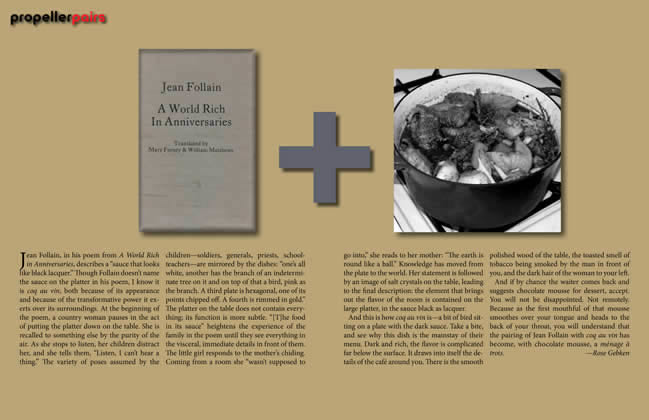
from the April 2011 issue
Jean Follain, in his poem from A World Rich in Anniversaries, describes a “sauce that looks like black lacquer.” Though Follain doesn’t name the sauce on the platter in his poem, I know it is coq au vin, both because of its appearance and because of the transformative power it exerts over its surroundings. At the beginning of the poem, a country woman pauses in the act of putting the platter down on the table. She is recalled to something else by the purity of the air. As she stops to listen, her children distract her, and she tells them, “Listen, I can’t hear a thing.” The variety of poses assumed by the children—soldiers, generals, priests, schoolteachers—are mirrored by the dishes: “one’s all white, another has the branch of an indeterminate tree on it and on top of that a bird, pink as the branch. A third plate is hexagonal, one of its points chipped off. A fourth is rimmed in gold.” The platter on the table does not contain everything; its function is more subtle. “[T]he food in its sauce” heightens the experience of the family in the poem until they see everything in the visceral, immediate details in front of them. The little girl responds to the mother’s chiding. Coming from a room she “wasn’t supposed to go into,” she reads to her mother: “The earth is round like a ball.” Knowledge has moved from the plate to the world. Her statement is followed by an image of salt crystals on the table, leading to the final description: the element that brings out the flavor of the room is contained on the large platter, in the sauce black as lacquer.
And this is how coq au vin is—a bit of bird sitting on a plate with the dark sauce. Take a bite, and see why this dish is the mainstay of their menu. Dark and rich, the flavor is complicated far below the surface. It draws into itself the details of the café around you. There is the smooth polished wood of the table, the toasted smell of tobacco being smoked by the man in front of you, and the dark hair of the woman to your left.
And if by chance the waiter comes back and suggests chocolate mousse for dessert, accept. You will not be disappointed. Not remotely. Because as the first mouthful of that mousse smoothes over your tongue and heads to the back of your throat, you will understand that the pairing of Jean Follain with coq au vin has become, with chocolate mousse, a ménage à trois. —Rose Gebken
Rose Gebken is a writer and editor in Portland, Oregon.











